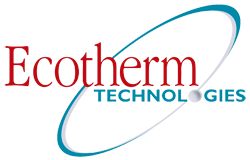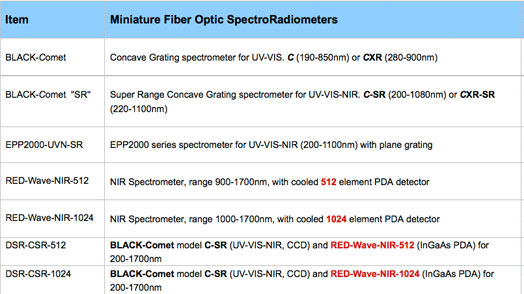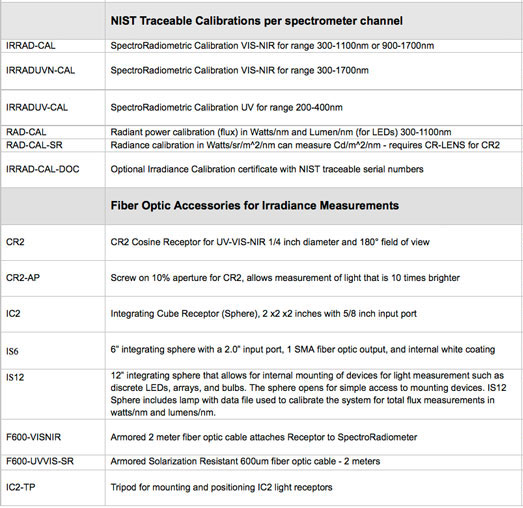 |
The StellarNet model spectrometers are great tools for low cost, routine analysis of all types of light.
|
|
The StellarNet model spectrometers are great tools for low cost, routine analysis of all types of light. From measuring the irradiance of standard light bulbs to measuring the exact color coordinates of the yellow in a traffic light, StellarNet spectrometers are used worldwide to routinely analyze light. These instruments are calibrated to measure the spectral irradiance in units of watts per meter squared over the wavelength range in nanometers provided by the selected spectrometer model. Currently, StellarNet offers Radiometer systems in the 200-1700nm range. The the bottom of the page details the various ranges for each StellarNet Spectroradiometer. The BLUE and GREEN-Wave models, BLACK-Comet concave grating model, and RED-Wave-NIR InGaAs model can be configured to have the correct slit size and detector array to suite your application. Calibrated spectroradiometers can be used to measure absolute intensity, xy chromaticity (CIE 1931), purity, correlated color temperature, and dominant wavelength.
- Absolute intensity measurements watts/m2 - µm watts/cm2 - PSD - Lumens/m2 -- LUX - Moles per second -- PAR - Footcandles /m2 - Radiant Flux (watts) / Luminous Flux (lumens) - xy Chromaticity, dominant wavelength, purity - Correlated color temperature (CCT) - Set Power Spectral Density (PSD) range StellarNet also has extended range spectroradiometers available to measure spectral irradiance over a wide range of wavelengths. The EPP2000-UVN-SR spectroradiometer with CCD detector array covers a range of 200-1100nm. The BLACK-Comet-SR super range, dual blazed, concave grating spectroradiometer offers a range of 220-1100nm while retaining all of the characteristics of a concave grating spectrometer!!! In addition, StellarNet offers a Dual Channel Spectrometer system for spectroradiometry, the Dual DSR (Detector Super Range) combines a CCD and InGaAs detector to cover a wavelength range of 200-1700nm for selected models.
Dual DSR Spectroradiometer Halogen-lamp spectra (300-1700nm). StellarNet Dual DSR system pictured above uses a Y bifurcated fiber (F600-Y-UVSRNIR) to connect a BLACK-Comet-SR spectrometer and a RED-Wave NIR Spectrometer. The entire system can be radiometrically calibrated over the range 200-1700nm. Above system pictured with Flash Capture Interface (FCI) that allows spectrometer to capture emission from flashing sources such as flashtubes and pulsed solar simulators. Many popular applications involve measuring the irradiance of light sources with low output intensities. From ambient streetlight to UV-LEDs many people need to detect low levels of radiation. StellarNet spectrometers can be specially configured to measure these low light levels. The spectrometer aperture or slit can be adjusted to allow more light into the unit, thus making it more sensitive to radiation. For low light applications a 200um slit is the standard slit size. Additionally, low light level calibrations can be employed to further optimize the spectrometers ability to see low light levels. And lastly, a TEC cooler can be installed on the detector array to increase the signal to noise of the unit by 66%. This in affect allows the spectrometer to integrate over longer periods of time, collecting more and more photons, while keeping a low noise value. If you have a low light application be sure to talk to a StellarNet sales engineer to discuss the configuration of your spectrometer. In contrast, many industries require the measurement of really bright light emission. StellarNet spectrometers have a dynamic range of 6 decades allowing integration times from 1ms to 65s. StellarNet spectrometers can be specially configured for high power applications. The limitation of a high power radiometer will be limited by the power of the calibration source. StellarNet can configure Spectroradiometers to optimize calibration thus allowing the use of the units large dynamic range and detector linearity to allow high power light measurement. Additionally, smaller slits, fibers, and integration spheres can be employed to decrease the signal to the spectrometer. StellarNet offers a high light level calibration to further optimize the system performance.
EPP2000-UVN-SR Metal Halide and High Power Sodium Lamps displaying Area Power Spectral Density, Centriod, Peakwave, FWHM, and CentBase.
Portable spectrometers include a high speed USB-2 interface cable. All miniature spectrometers with a CCD detector (GREEN-Wave, BLUE-Wave, BLACK-Comet, and new EPP2000 models) are powered by your computer's USB port while spectrometers with InGaAs detectors (RED-Wave) require an external 5V supply. New Big Wave electronics allow plug in play operation through on board memory where all coefficients are automatically loaded into your software. - UV-VIS-NIR Ranges 200-2300nm - Low cost - Ruggedized high performance - Shock-proof - Permanently aligned - SpectraWiz Software included Free - Battery packs for field measurements - USB-2 interface to all notebook PCs The factory performs calibrations for the appropriate wavelength range of your spectrometer using NIST traceable calibration lamps (calibration service IRRAD-CAL must be ordered with spectrometer and proper measurement accessories) Fast delivery: most system can be calibrated and shipped within 1 week after receipt of order Absolute calibration: accuracy within 10% at detector integration setting used for calibration Certificate available: documentation with NIST traceable serial numbers. If the user has an appropriate irradiance calibration source lamp, a field re-calibration can be easily performed using the included SpectraWiz software
Experimental Setup for Laser, Laser Diode, and LED characterization. Larger Spheres such as IS6 and IS12 can be used in place of low cost IC2.
StellarNet Cosine Receptors allow collection of light with an 180 field of view using demountable diffusers with ~10% loss. The CR1-UVN is a ½” diameter near cosine receptor using a sanded fused silica diffuser for 200-1700nm and has reduced 90° FOV and only low 7% loss.
StellarNet Integration Spheres allow collection of light with an 180 field of view. The IC2 is a 2" internal diameter sphere with 2 SMA connectors for illumination and collection of LED light. The input port is 5/8". The IS6 and IS12 are 6" and 12" StellarNet integration spheres with 2.5" input port with internal white coating. Mounting tripods and other accessories are available for LED measurement. SpectraWiz Software displaying 1931 xy chromaticity diagram measuring the color and Correlated Color Temperature (CCT) of an LED. SpectraWiz Software allows the users to select the irradiance units. Additionally, scroll down menus allow the user to select their collection accessory in order to calculate radiant and luminous flux. BLACK-Comet spectrometer calculating LUX values of a bright source. StellarNet spectroradiometers are all calibrated first with base units of irradiance in W/m^2. SpectraWiz software applies different factors and algorithms in real-time to calculate your favorite comparison value (e.g. Lumen, footcandle, CCT, etc).
|
|
|
|
|





















